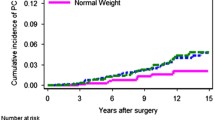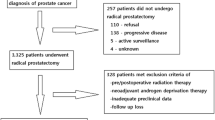Abstract
Introduction
Obesity might negatively affect prostate cancer (PCa) outcomes. However, evidence according to the associations between obesity and metastases-free survival after radical prostatectomy (RP) is still inconsistent.
Methods
We relied on PCa patients treated with RP at the Martini-Klinik Prostate Cancer Center between 2004 and 2015. First, multivariable Cox regression analyses examined the impact of obesity on metastases after RP. Last, in a propensity score matched cohort, Kaplan–Meier analyses assessed metastases-free survival according to body mass index (kg/m2) (BMI) strata (≥ 30 vs. < 25).
Results
Of 13,667 individuals, 1990 (14.6%) men were obese (BMI ≥ 30). Median follow-up was 36.4 month (IQR 13.3–60.8). Obese patients were less likely to exhibit metastases after RP (HR 0.7, 95% CI 0.5–0.97, p = 0.03). Similarly, after propensity score adjustment, obesity was associated with increased metastases-free survival (log rank p = 0.001).
Conclusion
We recorded the obesity paradox phenomenon in PCa patients. In particular, high BMI (≥ 30) was associated with decreased risk of metastases after RP, despite an increased risk being anticipated. Whether statin use might have affected the results was not assessed. Further research is needed to unravel the controversially debated association between obesity and PCa.

Similar content being viewed by others
References
Calle EE, Rodriguez C, Walker-Thurmond K, Thun MJ (2003) Overweight, obesity, and mortality from cancer in a prospectively studied cohort of U.S. adults. N Engl J Med 348(17):1625–1638
Ligibel JA, Alfano CM, Courneya KS et al (2014) American Society of Clinical Oncology position statement on obesity and cancer. J Clin Oncol 32(31):3568–3574
van Roermund JG, Hinnen KA, Tolman CJ et al (2011) Periprostatic fat correlates with tumour aggressiveness in prostate cancer patients. BJU Int 107(11):1775–1779
Laurent V, Guerard A, Mazerolles C et al (2016) Periprostatic adipocytes act as a driving force for prostate cancer progression in obesity. Nat Commun 7:10230
Discacciati A, Orsini N, Wolk A (2012) Body mass index and incidence of localized and advanced prostate cancer–a dose-response meta-analysis of prospective studies. Ann Oncol 23(7):1665–1671
Schiffmann J, Salomon G, Tilki D, Budäus L, Karakiewicz PI, Leyh-Bannurah SR, Pompe RS, Haese A, Heinzer H, Huland H, Graefen M, Tennstedt P (2017) Radical prostatectomy neutralizes obesity-driven risk of prostate cancer progression. Urol Oncol 35(5):243–249
Allott EH, Masko EM, Freedland SJ (2013) Obesity and prostate cancer: weighing the evidence. Eur Urol 63(5):800–809
Siddiqui SA, Inman BA, Sengupta S et al (2006) Obesity and survival after radical prostatectomy: a 10-year prospective cohort study. Cancer 107(3):521–529
Magheli A, Rais-Bahrami S, Trock BJ et al (2008) Impact of body mass index on biochemical recurrence rates after radical prostatectomy: an analysis utilizing propensity score matching. Urology 72(6):1246–1251
Dickerman BA, Torfadottir JE, Valdimarsdottir UA, Wilson KM, Steingrimsdottir L, Aspelund T, Batista JL, FallK Giovannucci E, Sigurdardottir LG, Tryggvadottir L, Gudnason V, Markt SC, Mucci LA (2017) Midlife metabolic factors and prostate cancer risk in later life. Int J Cancer 142(6):1166–1173
Alderton GK (2016) Tumour microenvironment: obesity promotes prostate cancer invasion. Nat Rev Cancer 16(2):70
Efstathiou JA, Bae K, Shipley WU et al (2007) Obesity and mortality in men with locally advanced prostate cancer: analysis of RTOG 85-31. Cancer 110(12):2691–2699
Flegal KM, Carroll MD, Ogden CL, Curtin LR (2010) Prevalence and trends in obesity among US adults, 1999–2008. JAMA 303(3):235–241
Berghofer A, Pischon T, Reinhold T, Apovian CM, Sharma AM, Willich SN (2008) Obesity prevalence from a European perspective: a systematic review. BMC Public Health 8:200
Chun FK, Briganti A, Graefen M et al (2007) Body mass index does not improve the ability to predict biochemical recurrence after radical prostatectomy. Eur J Cancer 43(2):375–382
Cao Y, Ma J (2011) Body mass index, prostate cancer-specific mortality, and biochemical recurrence: a systematic review and meta-analysis. Cancer Prev Res (Phila) 4(4):486–501
Gong Z, Agalliu I, Lin DW, Stanford JL, Kristal AR (2007) Obesity is associated with increased risks of prostate cancer metastasis and death after initial cancer diagnosis in middle-aged men. Cancer 109(6):1192–1202
Wang LS, Murphy CT, Ruth K, Zaorsky NG, Smaldone MC, Sobczak ML, Kutikov A, Viterbo R, Horwitz EM (2015) Impact of obesity on outcomes after definitive dose-escalated intensity-modulated radiotherapy for localized prostate cancer. Cancer 121(17):3010–3017
Geinitz H, Thamm R, Mueller T et al (2011) Impact of body mass index on outcomes after conformal radiotherapy in patients with prostate cancer. Int J Radiat Oncol Biol Phys 81(1):16–22
Renehan AG, Sperrin M (2016) The obesity paradox and mortality after colorectal cancer: a causal conundrum. JAMA Oncol 2(9):1127–1129
Zheng W, McLerran DF, Rolland B et al (2011) Association between body-mass index and risk of death in more than 1 million Asians. N Engl J Med 364(8):719–729
Lennon H, Sperrin M, Badrick E, Renehan AG (2016) The obesity paradox in cancer: a review. Curr Oncol Rep 18(9):56
Doehner W, von Haehling S, Anker SD (2015) Protective overweight in cardiovascular disease: moving from ‘paradox’ to ‘paradigm’. Eur Heart J 36(40):2729–2732
Roberts DL, Dive C, Renehan AG (2010) Biological mechanisms linking obesity and cancer risk: new perspectives. Annu Rev Med 61:301–316
Raval AD, Thakker D, Vyas A, Salkini M, Madhavan S, Sambamoorthi U (2015) Impact of metformin on clinical outcomes among men with prostate cancer: a systematic review and meta-analysis. Prostate Cancer Prostatic Dis 18(2):110–121
Alfaqih MA, Allott EH, Hamilton RJ, Freeman MR, Freedland SJ (2017) The current evidence on statin use and prostate cancer prevention: are we there yet? Nat Rev Urol 14(2):107–119
Zhang X, Zhou G, Sun B et al (2015) Impact of obesity upon prostate cancer-associated mortality: a meta-analysis of 17 cohort studies. Oncol Lett 9(3):1307–1312
Cox ME, Gleave ME, Zakikhani M et al (2009) Insulin receptor expression by human prostate cancers. Prostate 69(1):33–40
Ma J, Li H, Giovannucci E et al (2008) Prediagnostic body-mass index, plasma C-peptide concentration, and prostate cancer-specific mortality in men with prostate cancer: a long-term survival analysis. Lancet Oncol 9(11):1039–1047
Author information
Authors and Affiliations
Contributions
JS protocol/project development, data analysis, manuscript writing/editing, data collection or management. PIK manuscript writing/editing. MR data collection or management. LM manuscript writing/editing. GS data collection or management. DT data collection or management. LB data collection or management. RP data collection or management. S-RL-B data collection or management. AH data collection or management. PH manuscript writing/editing. HH data collection or management. MG data collection or management, protocol/project development. PT data collection or management, protocol/project development, data analysis.
Corresponding author
Ethics declarations
The study was conducted according to the principles of the declaration of Helsinki.
Conflict of interest
The authors declare that they have no conflict of interest.
Rights and permissions
About this article
Cite this article
Schiffmann, J., Karakiewicz, P.I., Rink, M. et al. Obesity paradox in prostate cancer: increased body mass index was associated with decreased risk of metastases after surgery in 13,667 patients. World J Urol 36, 1067–1072 (2018). https://doi.org/10.1007/s00345-018-2240-8
Received:
Accepted:
Published:
Issue Date:
DOI: https://doi.org/10.1007/s00345-018-2240-8




